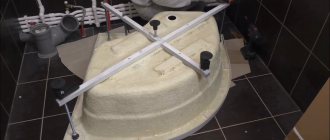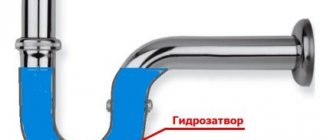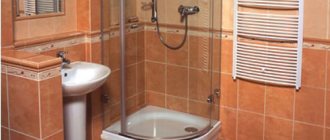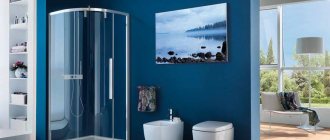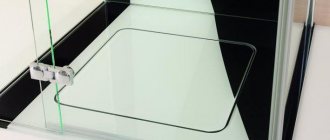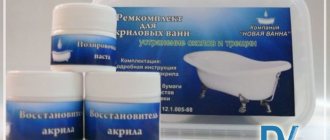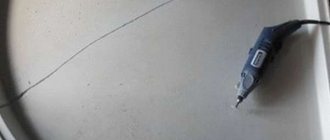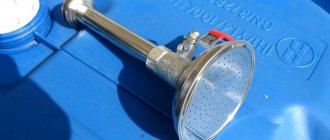Today, many people prefer to install a shower stall in the bathroom during renovation. And most often, cabins of this type are equipped with all the necessary additional elements. These include all kinds of massagers, installations for regulating water flow, and the like.
Shower cabin arrangement diagram.
Considering that most often when installing a hydromassage shower cabin the presence of a standard bath is completely excluded, it is advisable to provide a steam generator. As a rule, connecting such an accessory with your own hands to the shower stall will provide steam, which will help you feel exactly like in a good sauna.
Principle of operation
Shower stalls are usually equipped with household steam generators, the operating principle of which is practically the same from model to model.
The simplest device consists of a water tank equipped with a heating element and a system of 3 solenoid valves. The first valve is needed to fill the tank with water, the second to supply steam to the cabin, and the third to drain the remaining water into the sewer. The operating procedure of such a system is as follows:
- the sensor measures the water level in the tank and if it is below the set level, the water supply valve opens;
- after the required level is reached, the valve closes and the heating turns on;
- the user can set on the control unit the temperature in the cabin to which heating will be carried out. After reaching it, the heating elements are turned off;
- the control unit ensures that the required water level is maintained in the tank and periodically opens the valve to fill;
- after the procedure is completed, the discharge valve opens and excess water goes into the sewer
Installation technology
Preparatory stage. Before installing the steam generator, you should prepare the shower cabin. Complete sealing will allow the device to work efficiently. This can be achieved by installing a special cap at the top. In some models, this element is provided by the manufacturer. If it is missing, then the part must be purchased at the store. During preparatory work, air convection is needed inside the bathing box. It will be enough to provide several fans. A good option is considered to be devices with a power of 12 W, which ensure the movement of air masses necessary for steam procedures.
It will be interesting: Comparative review of electric and gas water heaters
When connecting the device, you must follow safety rules. Contact of an electrical wire that is energized with water vapor often causes a short circuit. It is recommended to consider installing the steam generator outside the bathroom. To do this, you need to install a steam supply pipe in the shower stall.
Tools and materials
To install the device correctly, prepare the necessary tools for the job. The craftsman needs to have a drill and a set of drills, dowels and screws, an adjustable wrench, a flexible metal hose, and a copper pipe. It is worth providing plastic pipes that allow you to connect the steam generator to the drain. To select the diameter of the pipes and hose before work, read the manufacturer's instructions.
What are they?
Let's first figure out what kind of steam generators there are. They can be divided into 3 main types based on their operating principle:
- electrode;
- with heating element;
- induction
Electrode. The water in such devices heats up and turns into steam when an electric current passes. The main advantage of this design is the absence of scale.
With a regular heating element . This is the most common and cheapest type of steam generators, which are installed in most modern cabins. They are equipped with the usual heating elements in the form of tubes. And the principle of their operation is similar to a regular boiler.
Induction. Heating of water in such systems is carried out due to high-frequency radiation, which transfers its energy to the walls of the water tank.
Their main advantage is that the energy consumption for converting water into steam is 3-4 times lower than when using heating elements.
Kinds
Depending on what heating elements are used in the device, the following types are distinguished:
- heating elements, the water in which is heated by electric heating elements of varying power;
- induction, heating water using high-frequency radiation;
- electrode, where electric current coming from built-in electrodes is used to heat water.
Please note: heating elements primarily affect steam generator parameters such as temperature and steam supply speed. Its cost also depends on them.
Is it worth doing it yourself?
Many consumers want to save money and try to make a steam generator with their own hands. They are usually made from an empty gas cylinder. Tubes with valves cut into it to fill the tank with water and supply steam. Heating elements are installed inside the cylinder and connected to the electrical network.
The big problem with such steam generators is that they do not provide any protection against boiling water.
Therefore, their use is extremely dangerous and can result in a fire. We do not recommend making steam generators yourself .
Installing a steam generator: why is it better to do it yourself?
Unfortunately, the cost of the simplest shower cabin with a steam generator is quite high and can vary over a very wide range. That is why many steam lovers are wondering: how to make and install a steam generator for a shower cabin yourself?
Today, many different options and schemes are offered, according to which a steam generator for a shower cabin can be installed.
Installation of a closed shower cabin with a steam generator.
For example, many offer the following method: a used gas cylinder is drilled out and heating elements are welded into it, with the help of which the water will be heated to a vapor state. However, it is better to abandon the idea of installing such a design: it is absolutely unsafe, especially in an apartment building. In the event of an emergency, an explosion of such a structure can destroy not only your apartment, but also the entire entrance.
Therefore, installing a steam generator for a shower cabin that is safe and reliable can be done only in one way - by purchasing a ready-made device and installing it in the shower. In this case, improving and remodeling the cabin will not require large amounts of time and money.
Currently, specialized stores sell electric steam generators for shower stalls of a wide variety of power and price ranges. You can purchase a miniature model with a minimum of options and functions, and if you wish and have the money, you can buy a multifunctional option that will allow you to provide the aroma of essential oils and steam to an entire sauna. The costs associated with installing a steam generator for a shower cabin can vary widely. It all depends on the design features and available functions. For an ordinary apartment cabin, a simple and inexpensive model with a power of several kW is suitable.
Related article: How to choose shower doors
Diagram of a hydromassage shower cabin with a steam generator.
The most important condition is to ensure the cabin is sealed and forced air convection. To do this, you need to install a sealed cap on top of the shower, if it is not originally provided for in the model, and build one or more fans into the design. It is not necessary to create a draft in the shower - several 12 V fans, like those used to cool the system units of personal computers, will be enough.
The situation with connecting a steam generator for a shower cabin to electricity is a little more complicated: dampness in the bath and live wires are a potential source of an emergency. Therefore, it would be much more reasonable to install a steam generator in some dry room, and then run a steam supply pipe from it to the shower stall. The installation of a steam generator for a shower cabin can be done directly to the water supply.
To ensure that the installation of a steam generator for a shower cabin is carried out correctly, and the life of the device is longer, do not forget to drain the residues from it and descale it from time to time.
Secrets of choice
The first thing you need to decide is whether you want to purchase a shower cabin with a built-in steam generator, or buy it separately and improve your existing cabin.
If you need a ready-made kit, we recommend reading our special article about shower cabins with sauna and bathhouse. For those who want to purchase a steam generator separately, we have collected a number of criteria that you should pay attention to when purchasing it .
Volume of the tank. The steam output of the system directly depends on this parameter. For domestic needs, a tank with a volume of 3-5 liters will be sufficient . This is just enough to fill the space of a medium-sized shower stall with thick steam.
Steam temperature. The steam temperature that the steam generator can produce ranges from 40 to 60 degrees. If you want to achieve maximum heating, it is better to choose a device capable of producing steam at 60 degrees.
Performance. Its optimal value is 2-4 kg/h. It is worth noting that the higher the value of this parameter, the faster the steam will fill the shower box.
Type of instalation. There are wall-mounted and floor-mounted models of steam generators. It will be more organic if it hangs on the wall, since in this case the device will not hide additional space.
Control. The generator can be controlled both locally and remotely.
It is better to choose models that are equipped with control panels. In this case, you will be able to control the steam parameters directly from the shower stall.
Rules that, if followed, will allow you to avoid mistakes during installation
- The room where the steam generator will be installed needs good ventilation.
- At the bottom of the wall it is necessary to locate the entry point of the steam pipe into the bathroom.
- The distance between walls, floor and device must be at least 50 cm.
- The steam pipe should be fixed at a slight inclination towards the shower stall. So, condensed moisture on the surface of the pipe can flow down.
- To install the generator, you need to allocate an area of at least 0.25 square meters. m. There are cases when a larger area is needed. This depends on the selected steam generator model.
How to connect?
It is worth noting that the steam generator cannot be installed in any shower stall; it must be:
- hermetically sealed - so that steam does not escape from the cabin and does not create increased humidity in the bathroom;
- equipped with a forced air - this is necessary in order to disperse steam throughout the cabin;
- have nozzles - through which steam will be supplied.
A prerequisite for installing a steam generator is the installation of a coarse filter on a suitable cold water supply pipeline.
This will prevent large pieces of rust from getting into the tank. But to increase the service life of the heating elements, it is recommended to install a hard water filter. This solution will prevent scale formation. If all conditions are met, you can proceed with installation.
Scheme
Below, for greater clarity, a detailed diagram of the steam generator is presented.
Elements:
- steam nozzle;
- steam line;
- discharge into the sewer;
- coarse filter on the cold water supply;
- thermocouple;
- rear part of the cabin;
- thermocouple wire;
- steam supply valve;
- stub;
- control Panel
- power button;
- thermostat;
- indicator of water level in the tank;
- power cable;
- from a level meter;
- steam generator power supply.
Installation instructions
Step 1. First of all, you need to choose a place to install the steam generator . It would be best to mount it in another room. This is a plus, both from an aesthetics and safety point of view. After all, high humidity can not only damage the device, but also lead to electric shock.
A storage room is perfect for these purposes if it has communications. The main condition is that the distance from the steam generator to the shower stall should be no more than 5-7 meters . Otherwise, the steam will cool and condense.
For some shower cabins that come with a steam generator, it can be installed directly on the back side of the cabin.
Step 2. The next stage is installation . If the device is floor-mounted, then everything is simple, it is only important to install it so that people do not trip over the supplied communications.
If the device is attached to the wall, everything is a little different. First you need to make holes in the wall using a hammer drill. Then hammer the dowels into them and screw in the screws. Now you can hang the steam generator by the special “ears”.
Step 3. Connecting communications . As a rule, the water inlet valve is connected to the water supply using a flexible connection. Exactly the same as on regular taps. The connection to the sewer is made using a special corrugated tube included in the kit.
Step 4. Steam line . The steam pipe is mounted at a slight slope towards the shower stall. This is necessary so that the condensate does not stagnate in the system, but drains on its own. As a result, the tube is connected to the steam nozzle on the shower stall itself.
Steam nozzles must be located at the bottom of the cabin. This is due to the fact that with this design option, the steam will gradually rise to the top, and the cabin will warm up more evenly.
Step 5. Temperature sensor . The next step is connecting and installing the temperature sensor. As a rule, it is a small sleeve with wires. They must be connected to the appropriate terminals according to the instructions. The sensor itself is mounted at the top of the shower stall. If there is no specially provided hole for it, you can carefully drill it according to the diameter of the sleeve and seal it.
Step 6: Control Panel . The control panel is mounted directly on the shower stall or next to it. For beauty and convenience, it is better to provide a place for it in the wall in advance and route the wiring there.
Modern control panels are wireless. They communicate with the steam generator unit via Wi-fi or bluetooth. This allows you to make them portable and get rid of unnecessary wires.
Step 7. Connecting to the electrical network . The socket into which the steam generator will be connected must necessarily go through an RCD. This requirement is primarily due to the fact that the device has direct contact with water, and in the event of a leak, the RCD will interrupt the power supply.
Connecting to networks
Connection diagram of the steam generator to the water supply system.
Now, as for the work on connecting the steam generator to the necessary communications. First you need to screw the drain tube from below. It should be located slightly on a slope and go into the bathroom. There it can be put into the toilet, shower stall, or into a special container. It will remove unnecessary condensate formed during operation of the installation.
After this, start connecting to the water supply. Any model of steam generator contains a special magnetic valve on its body. It is this that forces water and steam to move through the tubes, thereby ensuring proper operation of the device.
Using a plastic tube, connect the body of the steam generator to the water pipe. It is very important that the water in this pipe is clean. After all, it is from this that steam will be generated for the shower stall. The connection must be made by first shutting off the water and draining it from the pipe. A hole is made in the pipe into which a piece of tube is attached using a special adapter. It is advisable to seal the fum with tape and special rubber gaskets.
By the way, sealing with gaskets and fum tape must be done while connecting the tube that will remove condensate. After all, even small drops of moisture that can pass through the tube will reduce the safety of using the structure and ruin the floor covering.
The unit must be connected to the shower stall using a flexible tube. One end of the tube is connected according to the diagram to the body of the steam generator, and the other end is attached to the shower stall itself. Fastening is also carried out according to the diagram attached to the device.
The last step is to connect to the electrical part. This should only be done when the tightness of the connection to the water supply has been checked by turning on the water and filling the generator housing with it. Before connecting, you must turn off the electricity and do everything as indicated in the diagram.
It is very important that the electrical part is made as reliably as possible. Therefore, if you do not have any electrician skills, then it is better to seek help from a professional specialist who will do everything correctly and save you from unnecessary pain and worry in the future. The quality of the sockets must be checked during repairs, before installing the steam generator.
Examination
Before using the installed system, it must be thoroughly checked. Start the steam generator from the control panel and set the required temperature. After some time, usually 4-5 minutes, you will see steam coming out of the nozzle. Turn off the heat and carefully inspect all connections. If there are no leaks and the machine in the panel has not been knocked out, you can start the system again.
We hope that our article helped you find out what steam generators for a shower stall are and how best to install them.
How to install a wall-mounted steam generator
- Mark the locations for fasteners on the wall.
- Drill holes for dowels in the required places.
- Install dowels.
- Screw self-tapping screws into the dowels.
- Hang the device on the fasteners.
- Connect the ball valve to the water supply with a flexible metal hose.
- Connect the apparatus and the steam line using a copper pipe.
- Install a plastic pipe.
- Attach a plastic pipe to the drain.
- Install the temperature sensor using a special wire, adjusting its position.
- Install the control panel and connect it.
- Connect the generator to the electrical network.
- Fill the device with water and check its operation.
When installing floor-standing steam generators, the methodology is no different except for the installation location.
About the reasons for the failure of steam generators
The design of a steam generator (even a fully automated one) is the simplest, but in some cases this device fails due to impurities contained in the water. Chlorine, metal salts, and iron particles cause scale formation on the walls of containers and pipelines.
To reduce the harmful effects of scale, it is recommended to do the following.
- Prevention of this phenomenon is the use of water purification filters, which are installed on the supply pipe.
- After bath procedures, the remaining water in the tank should be drained.
- Periodically clean the internal surfaces of the steam generator by adding citric acid, then thoroughly rinse the device.
By following these rules and recommendations, you can make your own steam generator (photos of some options can be seen in this article), which will last for many years if it is used correctly.
At the end of the article, we suggest that you familiarize yourself with a video tutorial that clearly demonstrates the process of manufacturing a steam generator.
Functions
The basic model is a cabin equipped with a “Turkish bath” function. It is small, the air humidity in it reaches 100%. Such a cabin heats up to 450C quickly, a comfortable temperature does not threaten burns when it comes into contact with metal parts of the structure.
Manufacturers offer saunas as options:
- Finnish;
- with infrared radiation.
The first of them can be considered an advertising gimmick by the manufacturer: in fact, it is impossible to warm up the cabin space to 1000C, and it is not necessary from the point of view of user safety. But the air humidity with this option will be no more than 30%, unlike the “Turkish bath”.
Cabins equipped with infrared emitters are divided into two sections:
- the first is a shower room;
- the second is a “steam room” with a wooden floor and infrared lamps.
The human body heats up quickly in infrared rays, and there is no source for increasing humidity.
In addition, the shower cabin can be equipped with:
- tropical shower;
- hydromassage bath;
- contrast shower.
For those who try to get maximum comfort even from plumbing equipment, telephones, stereo systems and even chromotherapy means are built into the cabins - a set of LED lights that color water jets in different colors.
What is a steam generator and why is it needed?
The first models of showers were simply a place for bathing.
They did not provide any additional functions. Modern units available on the market make it possible to turn the water procedure into a pleasure. There are entire spa complexes that are designed not only for washing, but also for relaxing and treating a cold. Among all models, those equipped with a sauna function are now especially popular.
A steam generator is a device equipped with a control system; it is capable of producing steam of varying humidity and temperature.
Showers equipped with this device are also called steam rooms. Using a steam generator in the bathing box, the effect of a Turkish bath is created .
This device is capable of heating steam up to 100 degrees. The main secret of the design is that the steam that enters the chamber has a temperature of no more than 60 degrees. This indicator is the most favorable for comfortable water procedures.
The thermal regime can be adjusted according to the desire of the person being washed. Due to health reasons, not everyone can afford to take a bath at high temperatures. If desired, the humidity in the box can be raised to 100%.
This design also provides for procedures such as aromatherapy and hydromassage. The process of bathing in a shower equipped with a steam generator turns into a healing process of psychotherapy.
Models that are equipped with this mechanism have wide functionality, so the price segment of such products belongs to the highest category. In addition to a steam bath, they can be equipped with a telephone, a stereo system, a forced ventilation system and other useful and not so useful functions.
Installing a steam generator in a shower is a very common practice today. The reason is quite banal - this mechanism successfully copes with the task assigned to it - converting ordinary water into steam.
Principle of operation
The operating principle of electric steam generators is very simple - they convert water poured into a tank into steam, which is discharged into the pipeline . In everyday life, only electric generators that produce steam are used. They work on heating elements. In industrial models, induction and electrode are used.
How does a cabin with a mini-steam room function work? There is a stainless steel tank with a heating element and a water level sensor installed inside it. Three tubes are welded to the container: water supply/drain and steam outlet.
There are solenoid valves on the supply/drain pipes. There is also a mechanism to prevent overheating. The steam generator is connected to the electronic control unit by wires. There is a temperature sensor inside the shower.
When the bath function is turned on, the following happens:
- The water supply valve opens.
- When the water reaches a certain level, the valve closes. This process is monitored by a level sensor.
- If the amount of water collected is not enough for the norm (this will be shown by a secondary measurement), the supply valve will open again and the missing liquid will be drawn.
- The power relay of the heating element is turned on, the water is heated to a boil. The heating element will not turn off until the temperature inside the unit reaches the user-specified temperature.
- The system monitors the water level. When boiling, it becomes less, it is added inside the tank by opening the supply valve.
- When the “bath” function is turned off, the water is drained into the sewer system.
As a rule, steam generators are equipped with several operating modes. Thanks to this multifunctional device, you can choose the optimal mode for yourself, which will be comfortable for taking water procedures. The temperature is adjustable over a wide range: from 35 to 95 degrees.
Inlet valve and water level sensor
The steam generator for the shower cabin is connected to the network. After this (in Stand-by mode) it depends on the algorithms laid down by the manufacturer. The solenoid inlet valve located at the inlet can open to draw water from the pipe (through the mesh). A number of manufacturers can standardize the pressure (3, 4 bar, etc.), so you need to ensure the required one. Otherwise, the operability of the system is not guaranteed, to the point that the steam generator will refuse to work at all.
As soon as the solenoid inlet valve is ready to accept pressure, filling of the tank begins. In this case, the excess air volume is released through the steam outlet (entering the cabin). This may be accompanied by the appearance of unpleasant odors. The water intake process continues until the sensor reports that the system is full. The power to the normally closed solenoid valve is then removed. If the sensor is clogged, the system will not be able to understand when it is time to stop collecting. Water will pour onto the floor of the shower stall and, hypothetically, could flood everything around. For this reason, a working Turkish bath should not be left unattended if there is a plug in the drain hole.
Note! The problem with the sensor is typical for many appliances, such as dishwashers and washing machines. This is a real storm for the neighbors. This is why the trays of washing machines and dishwashers are often equipped with leakage sensors.
It is recommended to install a leakage sensor in a shower cabin with a Turkish bath. Or place it somewhere in the vicinity. Few people today dare to ask why a plug is needed in the drain hole leading to the sewer. It is not very pleasant to sit and smell the aromas emanating from your neighbors (or your own).
